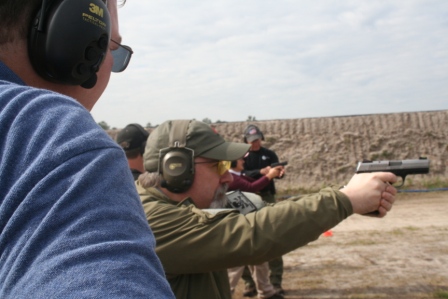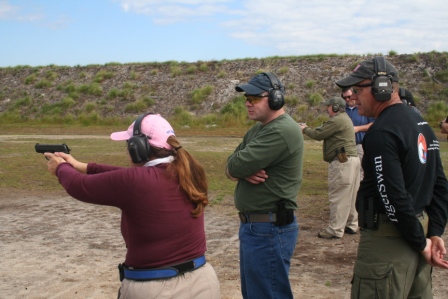Saturday was spent at the TigerSwan Training Collaboration Center taking an Introductory Pistol class with five other NC gun bloggers and a few other folks. I didn’t believe it was possible to learn so much in one day!
One of the drills we learned was called the Ball and Dummy Drill. A quick Google search shows that there are many variations of this drill. While some have criticized it, I found it a very helpful drill. The goal is to have the shooter stop anticipating the recoil or to stop jerking the trigger.
The variation we used did not involve using dummy rounds. Instead we paired off with one person shooting and the other person loading one round. With his or her back to the shooter, one person would either load or not load a magazine and then insert it into the shooter’s pistol. The pistol would then be handed to the shooter to take the shot.
 |
| Sean* acting as coach and loader |
I found that you could go a number of shots/non-shots and then screw up out of the blue. Then you had to make a mental note to concentrate on a smooth trigger pull and do it again and again.
I should note here that we did this drill while shooting at 25 yards at a B-8 target. Other variations of the drill suggest doing it at 3 yards.
 |
| Lynell being coached by George while instructor Brian Searcy watches. |
One of the other things instructor Brian Searcy added to the mix was to have the coach/loader put his hand in front of your face every so often and have you call the shot after you just took it. This helped up build awareness of where our shot went.
The only downside to not using dummy rounds involves pistols that have a loaded chamber indicator. If, like my Ruger SR9, the pistol has a loaded chamber indicator, then the loader and shooter have to make a conscious effort to hide that fact from the shooter. I know both I and Sean did make this effort.
This is a drill you can practice at any range whether indoor or outdoor. As I said earlier, I found it really valuable in helping develop a smooth trigger pull and in stopping anticipation.
*This Sean is not Sean Sorrentino but the other Sean in the class. We had two Georges and two Seans in the class.


I've been to many training courses from a couple different organizations. While I support new & novel training ideas, I have never witnessed loaded weapons being handed between trainees. The handguns were either in your holster or you were on the training line.
For safety sake, I would not recommend this practice (and would not want to be around while it was occuring). If the participants were back to back with others lined up next to them, how did each of the loaders turn around with a potentially loaded weapon?
Treat every weapon as if it's loaded and don't muzzle anything you don't want to annihilate. Even if the pistol is not chambered, at least 2 basic rules had to be broken in this activity.
@John: I have a loaded chamber indicator, so I made sure to bring my dummy rounds.
@mtallit: Since I was 2 people down from John when he was doing this I feel comfortable telling you that no one was muzzled during this drill. We did the drill safely because we were properly supervised and we aren't total idiots.
For those who aren't clear on the procedure, here's what we did. The shooter would hand the empty mag to the coach. While the shooter was taking a few practice dry fires, the coach would load a live round (or not) into the mag. The shooter would hand the pistol to the coach in such a way that the coach could take a normal grip with the right hand. The shooter would turn left, and the coach, taking care to keep the pistol pointed downrange, would turn right. This put them back to back. The coach would load mag into the pistol, and if equipped, would engage the safety. He would then turn downrange and hand the pistol back to the coach in a safe manner, taking care to keep the pistol pointed downrange the whole time.
It is a simple proceedure that takes longer to explain than it does to complete. It is safe, so long as no one acts like an idiot.
If you are at a range that has a bench, it is easier for the shooter to put the pistol on the bench and walk uprange turning his back. The coach can load the pistol and put it back on the bench. The shooter can then pick up the pistol and fire it. Lacking benches, our options were to hand the pistol, or put it into each other's holster. I preferred handing it across, and so did the class instructors.
Hi Sean, I just find that the more experience you have with weapons and the more you handle them, the more nonchalant you become. Only if you conscientiously adhere to very strict guidelines will likely never have an accident or if you do have an accident you minimize damage.
Based upon your additional explanation it sounds as though the pistol was pointed downrange at all times, which is better than what I had initialy understood.
Personally still, I never hand a gun to someone without first removing the mag and chamber checking and handing over separately the pistol, with the slide back, and mag. Just thinking about this range training activity makes me cringe if only because it is sooo ingrained in my psyche.
Regarding the dummy rounds, I also never mix my dummy rounds with live ammo. Human error, which could occur in re-sorting the rounds, would without a doubt poke its head out when you least like it to; like coming across a surprising live round when "dry firing" with the dummies.